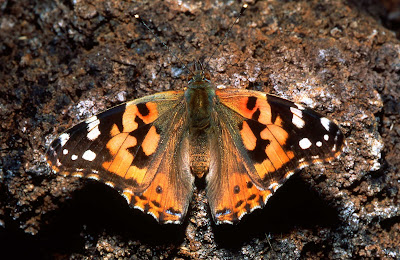Announcing Hawaii's official state insect!
Pulelehua, the Kamehameha butterfly (Vanessa tameamea), was announced as Hawaii's official State insect on April 23rd 2009.
The Kamehameha butterfly (Vanessa tameamea)
Photo: DOFAW
Photo: DOFAW
Pulelehua's host plant, Mamaki (Pipturus albidus), is an endemic nettle. These two species have evolved together and rely on each other for survival.
There is a new book called "Pulelehua and Mamaki" by Janice Crowl, which is a story about the relationship between these two special species.
Mamaki fruit and leaves at Hoolawa Farms, Maui.
Photo by Forest & Kim Starr
There is a new book called "Pulelehua and Mamaki" by Janice Crowl, which is a story about the relationship between these two special species.
There are only two butterflies native to Hawaii. The other is called Blackburn's blue, (Udara blackburni), and is pictured below.

Blackburn's blue butterfly (Udara blackburni)
Photo: DOFAW
Hawaii supports 955 species of native moths, but there are only 2 native Hawaiian butterflies. This is thought to be a result of the fact that moths are typically generalists, and butterflies depend on a specific host plant. As a side note, moths native to Hawaii are very small, with most only having a wingspan of 1 centimeter or less!
Native butterflies in Hawaii rely on native plants for important stages of their life cycles, which means there needs to be native areas containing native plants in order for these butterflies to survive.
To learn more about native Hawaiian butterflies and moths, and to read about what is being done to protect them, visit the Comprehensive Wildlife Conservation Strategy insect fact sheet.
For more information about butterflies and other native and non-native insects in Hawaii, visit the HEAR.org insect site.
Native butterflies in Hawaii rely on native plants for important stages of their life cycles, which means there needs to be native areas containing native plants in order for these butterflies to survive.
To learn more about native Hawaiian butterflies and moths, and to read about what is being done to protect them, visit the Comprehensive Wildlife Conservation Strategy insect fact sheet.
For more information about butterflies and other native and non-native insects in Hawaii, visit the HEAR.org insect site.





